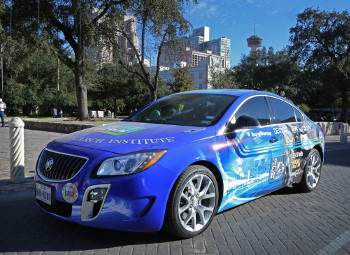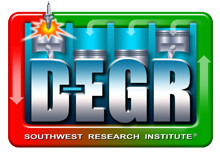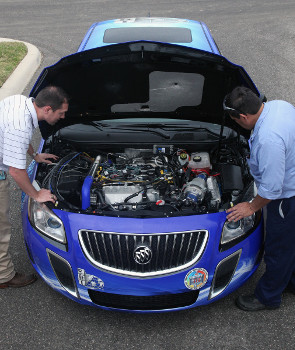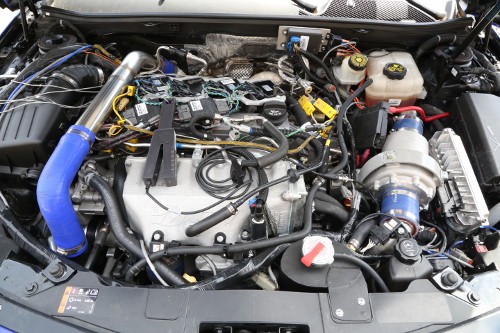 |
| July 22, 2014 | Volume 10 Issue 28 |
Designfax weekly eMagazine
Archives
Partners
Manufacturing Center
Product Spotlight
Modern Applications News
Metalworking Ideas For
Today's Job Shops
Tooling and Production
Strategies for large
metalworking plants
Wheels:
Exhaust recirculation tech and the road to 54.5 mpg
SwRI's dedicated EGR technology wins prestigious R&D 100 Award.

The drive to 54.5 miles per gallon just got shorter with SwRI's Dedicated EGR Demonstration Vehicle. The patented D-EGR technology was developed as part of the HEDGE consortium, led by SwRI, headquartered in San Antonio. [Image Courtesy: SwRI]
A new engine design that improves fuel economy and lowers exhaust emissions has received a prestigious 2014 R&D 100 Award. R&D Magazine selected Southwest Research Institute's (SwRI) Dedicated Exhaust Gas Recirculation (D-EGR) engine technology as one of the 100 most significant technological achievements introduced in the past year.
"Our engineers initially developed and demonstrated D-EGR technology in an engine test cell through SwRI's HEDGE (High-Efficiency Dilute Gasoline Engine) consortia," says SwRI Executive Vice President Walt Downing. "Under SwRI's internal research program, our engineers were able to solve the technical problems with making a D-EGR engine fit under the hood and operate on a current-production sedan. In 15 months, we took the concept from the laboratory to production viability."

Dedicated EGR technology is a novel engine architecture that is up to 15 percent more efficient than today's mainstream engines while simultaneously improving performance. Its design aims to allow manufacturers to address future, more aggressive Corporate Average Fuel Economy (CAFE) standards and meet LEV III/Tier 3 emissions levels cost effectively.

SwRI's patented Dedicated EGR technology can be integrated into almost any spark-ignited engine architecture. Because there are few additional components, it fits comfortably in an existing engine compartment without altering the engine's footprint. [Image Courtesy: SwRI]
To showcase the technology, SwRI engineers took a mid-size sedan and modified the current-production four-cylinder 2.0L gasoline engine so that exhaust from one dedicated cylinder is run with a rich mixture of fuel and air to reform gasoline fuel exhaust into carbon monoxide and hydrogen. This "reformate" exhaust gas is then cooled and looped into a patented mixer, where the EGR and reformate are mixed with fresh air before going into the engine intake.
"This technology developed by our automotive engineers is a significant leap forward in gasoline engine design. Recirculating exhaust gasses this way improves engine efficiency and fuel economy while simultaneously lowering exhaust emissions," says Bruce Bykowski, vice president of SwRI's Engine, Emissions and Vehicle Research Division. "With our D-EGR demonstration vehicle, the Institute has made a significant investment to validate the technology as a viable, production-ready alternative for automotive manufacturers."
The team of SwRI engineers designed several new components for the advanced combustion concept: the cooled EGR loop, the EGR mixer, and high-energy ignition system -- as well as engine-control software that enables in-cylinder fuel reformation.
Advances in engine design such as the D-EGR technology are especially critical given the current and upcoming regulatory climate. By 2025, automobile manufacturers will have to meet CAFE standards of 54.5 mpg. The Environmental Protection Agency is also expected to release new, more stringent emissions standards. Those two factors mean there is considerable industry focus on simultaneously improving both emissions and fuel efficiency, challenges which SwRI's demonstration vehicle addresses.
"The D-EGR concept takes the best attributes of regular cooled EGR and combines them with in-cylinder reformer technology. We segregate the exhaust of a cylinder of the engine so that one cylinder provides all of the recirculated exhaust gas back into the intake manifold," says Dr. Terry Alger, assistant director in SwRI's Engine, Emissions and Vehicle Research Division.

With SwRI's innovative Dedicated EGR engine technology, the combination of EGR and reformate increases the knock resistance of the engine, allowing high specific power at high compression ratios and enabling downsizing while increasing engine thermal efficiency. [Image Courtesy: SwRI]
"By running one cylinder rich, the excess fuel is reformed into hydrogen and carbon monoxide," adds Chris Chadwell, manager of SwRI's Spark Ignition Engine R&D section. "The in-cylinder reformation slightly reduces the carbon dioxide and water vapor while producing large volumes of carbon monoxide, which is a good fuel, and hydrogen, which is an outstanding fuel. That provides an octane boost and a flammability boost."
SwRI has won 38 R&D 100 Awards since 1971. Widely recognized as the "Oscars of Invention," R&D 100 Awards are selected by an independent panel of judges and editors of R&D Magazine and identify and celebrate the top technology products of the year. This year's award will be presented Nov. 7, 2014, in Las Vegas.
The Engine, Emissions and Vehicle Research Division, along with the Fuels and Lubricants Research Division, comprise SwRI's Automotive Engineering capabilities. The Institute is internationally known for its engine design and development activities and continues to uphold a longstanding tradition of quality and client response started almost 70 years ago.
Source: SwRI
Published July 2014
Rate this article
View our terms of use and privacy policy
